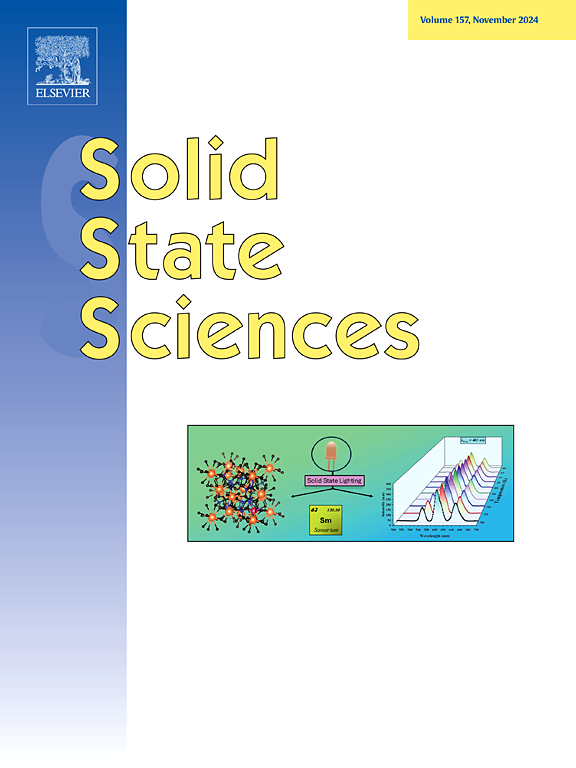磁性锶羟基磷灰石纳米棒净化水中Pb2+
IF 3.3
3区 化学
Q2 CHEMISTRY, INORGANIC & NUCLEAR
引用次数: 0
摘要
本研究采用一步水热法合成了不同磁性含量的磁性羟基磷灰石纳米棒Sr5(PO4)3(OH)/Fe3O4,简称FSP。然后研究了FSP材料作为水溶液中Pb2+的有效吸附剂。磁性含量为2 wt%的FSP材料(记为FSP2)具有较高的磁分离效率和Pb2+的去除能力。利用SEM、EDS、XRD、PPMS、BET和Zeta电位对FSP2进行了表征。FSP2在pH为5时的浸出率为~ 5%,表明其在水环境中具有优异的化学稳定性。研究了温度和材料用量两个影响参数对吸附效果的影响,最佳吸附条件为25℃,材料用量0.05 g。动力学和等温线数据分别符合拟二级动力学模型和Temkin模型。机理研究的EDS和XRD结果表明,Pb2+的吸附涉及离子交换和表面吸附。离子交换以Pb2+交换Sr2+为主。应用研究结果表明,FSP2在环境水样中对Pb2+的吸附量均大于600 mg g−1。由于制备方法简单,吸附性能好,磁性FSP2被认为是一种很有前途的吸附溶液中Pb2+的复合材料。本文章由计算机程序翻译,如有差异,请以英文原文为准。

Purification of Pb2+ in water by magnetic strontium hydroxyapatite nanorods
In this study, magnetic hydroxyapatite nanorods Sr5(PO4)3(OH)/Fe3O4, called FSP for short, with different magnetic contents were synthesized by one-step hydrothermal method. FSP materials were then investigated as effective adsorbents for adsorption of Pb2+ from aqueous solution. FSP materials with 2 wt% magnetic content (denoted as FSP2) exhibited high magnetic separation efficiency and Pb2+ removal capacity. Then, FSP2 were further characterized by SEM, EDS, XRD, PPMS, BET, and Zeta potential. FSP2 demonstrated a leaching rate of ∼5 % at pH 5, indicating excellent chemical stability in aqueous environments. Effects of two influence parameters (temperature and material dosage) were studied and the optimized adsorption conditions were 25 °C and material dosage of 0.05 g. The kinetic and isotherm data accorded with the pseudo-second-order kinetic model and Temkin model, respectively. The EDS and XRD results of mechanism study indicated that the adsorption of Pb2+ involves ion exchange and surface adsorption. Ion exchange Pb2+ for Sr2+ was predominant. The results of application research showed that the adsorption capacity of Pb2+ by FSP2 in environmental water samples was all higher than 600 mg g−1. Due to their easy preparation method and good adsorption capability, magnetic FSP2 are regarded as promising composite materials for the adsorption of Pb2+ from solutions.
求助全文
通过发布文献求助,成功后即可免费获取论文全文。
去求助
来源期刊

Solid State Sciences
化学-无机化学与核化学
CiteScore
6.60
自引率
2.90%
发文量
214
审稿时长
27 days
期刊介绍:
Solid State Sciences is the journal for researchers from the broad solid state chemistry and physics community. It publishes key articles on all aspects of solid state synthesis, structure-property relationships, theory and functionalities, in relation with experiments.
Key topics for stand-alone papers and special issues:
-Novel ways of synthesis, inorganic functional materials, including porous and glassy materials, hybrid organic-inorganic compounds and nanomaterials
-Physical properties, emphasizing but not limited to the electrical, magnetical and optical features
-Materials related to information technology and energy and environmental sciences.
The journal publishes feature articles from experts in the field upon invitation.
Solid State Sciences - your gateway to energy-related materials.
 求助内容:
求助内容: 应助结果提醒方式:
应助结果提醒方式:


